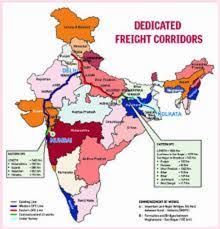By: Ravi Sinha
 Track2Realty Exclusive: Against all the prophecies of doomsday in the realty market, Delhi-NCR has not only grown in the last four-five years, but also has been among the best performing markets in the country. The growth has been slow but steady and analysts believe it is time the property market of Delhi-NCR needs a catalyst to put it on the fast forward mode of growth.
Track2Realty Exclusive: Against all the prophecies of doomsday in the realty market, Delhi-NCR has not only grown in the last four-five years, but also has been among the best performing markets in the country. The growth has been slow but steady and analysts believe it is time the property market of Delhi-NCR needs a catalyst to put it on the fast forward mode of growth.
This, of course, demands fast paced economic development since a growing economy and trade has a domino effect on the overall property market. The proposed Delhi Mumbai Industrial Corridors (DMIC) that promises to open the floodgates of new investment opportunities is expected to be that catalytic factor which promises to offer investors a gold mine once the project is over.
Referred as the most over ambitious infrastructure project in India and declared as one of 100 innovative global projects by consultancy firm KPMG, DMIC, a joint venture with Japan, the USD 90 billion infra project covering an overall length of 1483 KMs between the political capital and the business capital of India, i.e. Delhi and Mumbai, is poised to redefine the urban centres in the six States that it passes through— U.P, NCR of Delhi, Haryana, Rajasthan, Gujarat and Maharashtra.
There is no denying this high-speed connectivity between Delhi and Mumbai offers immense opportunities for development of an industrial corridor along the alignment of the connecting infrastructure. Urban planning experts are wondering whether the efforts to build a strong manufacturing base, quite like what Japan did after World War II, is destined to change the way Indian metro cities in general and Delhi-NCR in particular which is being seen as the emerging financial capital of India.
Amitabh Kant, CEO and MD of Delhi Mumbai Industrial Corridor Development Corporation (DMIDC) seems to be bullish when he says that the manufacturing hubs that the DMIC is creating will be critical to future growth. It is among the key components of the National Manufacturing Policy (NMP) that aims to raise the share of the manufacturing from 16 per cent of GDP to 25 per cent within a decade. The NMP would be a key enabler for DMIC. It is expected to create 10 crore new jobs by 2022.
Property developers and analysts in this part of the world believe North India in general and Delhi-NCR in particular is fast emerging as the epicentre of increased financial activity and the multinationals are preferring to make their base over here. The proposed Delhi Mumbai Industrial Corridor will take it forward to the next level where North India will be more beneficial than the Western part of the country due to better connectivity, infrastructure and overall lack of space constraint.
Since the growth of the real estate is directly linked to the overall economic development, the industrial corridor is poised to be the growth driver in the true sense of the term. Moreover, what makes DMIC project unique is the fact that it will create a level playing field in terms of the growth corridors across the regions it has been running into. Of course, Delhi-NCR is expected to gain more out of it, but it will lead to holistic growth of trade, economic activity and hence real estate.
Rohtas Goel, CMD of Omaxe asserts that the 12 National Investment and Manufacturing Zones (NIMZs) along the DMIC will boost the manufacturing sector and increase its contribution in the Indian economy to 25 percent by 2022. This in turn will create jobs, bring about socio-economic parity among States and as a result boost demand for housing. DMIC crosses through 6 States with an investment zone in each State. It will catalyze into transforming the real estate because creation of job will equally be aided by the economic development of smaller cities which in turn will see the demand for more housing.
“The empowerment of the people in tier II and III cities will be furthered by more infrastructure development that State Governments have begun to address. Since these cities offer land at a comparatively cheaper rate, developers will have an incentive to build affordable housing. The government needs to simultaneously speed up approval process and facilitate the sector. On the back of growing habitation and increased residential space, the development and demand for commercial space is inevitable. Also, growing income level and increased disposable income will see more demand for commercial space,” says Goel.
However, Pankaj Bajaj, Managing Director, Eldeco Infrastructure has a caveat here when he says the DMIC is an ambitious project with a grand vision. It has the potential to transform not only the affected area but also a large catchment. Just like other large projects in the country, there is always the danger of it getting delayed with land acquisition issues, environment clearances etc. On the other hand there is an example of Delhi Metro where a world class project has been successfully completed in a time bound manner and has actually changed the landscape of Delhi.
“DMIC is more challenging in that sense as not only political will at the Centre is required but also the cooperation of various state governments. But till now it seems to be going in a time bound manner and in fact the state governments are actually vying with each other to be first off the block. An example of the positive spinoff of DMIC is Neemrana where the real estate prices have appreciated more than 50% in the last 12 months and are likely to appreciate even more this year,” says Bajaj.
As a matter of fact, Neemrana is a major destination on the DMIC and already a vast area has been designated for development by DMIC. Large scale investments, both in industries and in the real setae space, are happening here in the anticipation of the DMIC project. These small non-descript destinations of Delhi-NCR may soon turn out to be ‘smart cities’ once the DMIC thrown open new investments and infrastructure opportunities.
Nikhil Jain, CEO of Ramprastha Group believes since the first phase of DMIC will pass through Delhi NCR region, so the region will get first mover advantage. Proximity with the National capital and central location of the region will again be an added advantage. According to him, in short run Delhi-NCR will continue to hold the numero uno position of property market.
“DMIC will open the floodgates of economic opportunities, if things as proposed and projected are executed accordingly then with development of new cities and residential township there would be an urgent need for commercial and trading activity, as every segment is interdependent on each other. Following which there would be intense requirement for quality commercial spaces for both offices and shopping complexes to support it holistically. Plans to develop integrated township and model cities to support them within the DMIC will further fuel the need for heavy commercial activity to support the residential as well as office requirements,” says Jain.
Urban planning experts even maintain that DMIC is eventually going to create a level playing field among the six states that the industrial corridor crosses over. After all, DMIC cannot be seen as only a highway project. Various industrial cities, townships will come along the industrial corridor across the states. These will bring holistic development bringing all the states at par in due course. DMIC will act as an artery connecting smaller cities and towns with world class infrastructure. This eventually will have a domino effect on the established property locations of Delhi-NCR.
DMIC Stats
Investment—USD 90 billion
Length—1483 KMs between Delhi and Mumbai
Covered States—U.P, NCR of Delhi, Haryana, Rajasthan, Gujarat and Maharashtra
End to End Terminals—Dadri in the National Capital Region of Delhi and Jawaharlal Nehru Port near Mumbai
Infrastructure Creation—Nine Mega Industrial zones of about 200-250 sq. km., high speed freight line, three ports, and six air ports; a six-lane intersection-free expressway connecting Delhi and Mumbai and a 4000 MW power plant
Jobs Creation—10 crore by 2022





